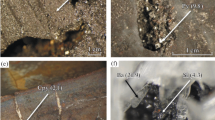Abstract
In December 1993, the first massive sulfides were recovered from the Indian Ocean floor, north of the Rodrigues Triple Junction. The polymetallic deposit is situated in the fourth Central Indian Ridge segment, close to the rift axis; it is hydrothermally no longer active. The deposit appears to be typical of mid-ocean ridge massive sulfide occurrences but is in a phase of disintegration and about to be buried by sediment. The chimney structures were formed by multiple hydrothermal events and are now degraded by mass wasting showing various stages of weathering. Later-stage, low-temperature hydrothermal mineralization processes led to copper and gold enrichment. Here we report on the geological setting, mineral zonation, different sulfide types and stages of formation of the “Sonne Sulfide Field”, which is part of a larger mineralized zone.
Similar content being viewed by others
Author information
Authors and Affiliations
Additional information
Received: 20 October 1997 / Accepted: 4 December 1997
Rights and permissions
About this article
Cite this article
Halbach, P., Blum, N., Münch, U. et al. Formation and decay of a modern massive sulfide deposit in the Indian Ocean. Mineral. Deposita 33, 302–309 (1998). https://doi.org/10.1007/s001260050149
Issue Date:
DOI: https://doi.org/10.1007/s001260050149




